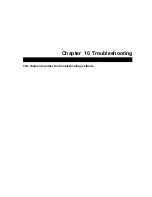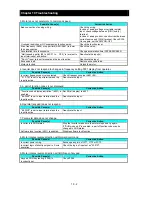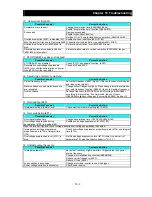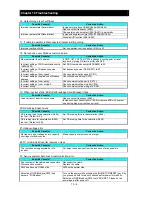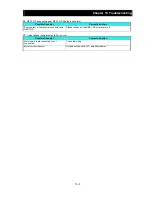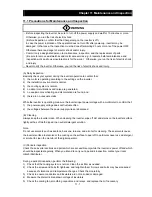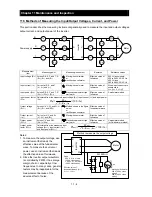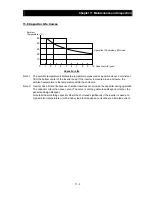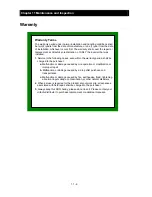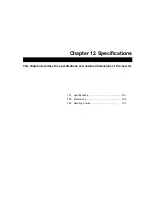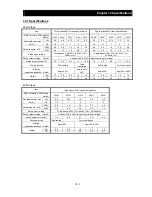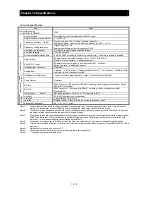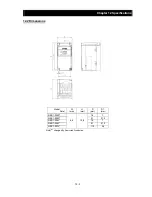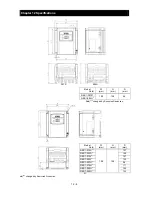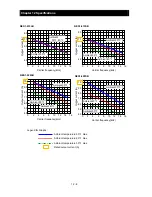
Chapter 11 Maintenance and Inspection
11 - 4
11.5 Methods of Measuring the Input/Output Voltages, Current, and Power
This section describes the measuring instruments generally used to measure the input and output voltages,
output current, and output power of the inverter.
I
R
I
S
I
T
E
R
E
T
E
S
W
I2
W
I3
W
I1
R
T
S
U
V
W
I
U
I
V
I
W
E
U
E
W
E
V
W
O2
W
O1
W
V
U
R
S
T
Power supply
Invert
er
Motor
Measurement
item
Measuring point
Measuring instrument
Remarks
Reference values
Input voltage (E
IN
) Across R-S, S-T, and T-R
(E
R
), (E
S
), and (E
T
)
Moving-iron voltmeter
or
rectifier-type voltmeter
Effective value of
full waves
200 V class models:
200 to 240 V, 50/60 Hz
400 V class
380 to 480 V, 50/60 Hz
Input current (I
IN
)
Current at R, S, and T
(I
R
), (I
S
), and (I
T
)
Moving-iron ammeter
Effective value of
full waves
When input currents are
unbalanced
I
IN
= (I
R
+ I
S
+ I
T
)/3
Input power (W
IN
) Across R-S, S-T, and T-R
(W
11
) + (W
12
) + (W
13
)
Electrodynamometer-type
wattmeter
Effective value of
full waves
3-wattmeter method
input power factor
(Pf
IN
)
Calculated from the measured input voltage (E
IN
), input current (I
IN
), and input power
(W
IN
)
Output voltage
(E
OUT
)
Across U-V, V-W, and W-U
(E
U
), (E
V
), and (EW)
Method shown in the figure
below
or
rectifier-type voltmeter
Effective value of
fundamental wave
Output current
(I
OUT
)
Current at U, V, and W
(I
U
), (IV), and (IW)
Moving-iron ammeter
Effective value of
full waves
Output power
(W
OUT
)
Across U-V and V-W
(W
01
) + (W
02
)
Electrodynamometer-type
wattmeter
Effective value of
full waves
2-wattmeter method
(or 3-wattmeter method)
Output power
factor (Pf
OUT
)
Calculated from the measured input
voltage (E
OUT
), input current (I
OUT
),
and input power (W
OUT
)
Notes:
1. To measure the output voltage, use
an instrument that reads the
effective value of the fundamental
wave. To measure the current or
power, use an instrument that reads
the effective value of full waves.
2. Since the inverter output waveform
is controlled by PWM, it has a large
margin of error, especially at low
frequencies. In many cases, general
testers may be inapplicable for the
measurement because of the
adverse effect of noise.
Method to measure the output voltage
R
T
S
Inv
e
rter
U
V
W
Motor
+
-
V
DC
2W 220
k
Diode
600 V, 0.1 A or more
(200 V class model)
1,000 V, 0.1 A or more
(400 V class model)
Effective value of
fundamental wave (V
AC
)
V
AC
= 1.1 x V
DC
Moving-coil voltmeter
300 V (200 V class
model)
600 V (400 V class
model)
Pf
IN
=
W
IN
√
3
・
E
IN
・
I
IN
×
100
(%)
Pf
OUT
=
W
OUT
√
3
・
E
OUT
・
I
OUT
×
100
(%)
Содержание NES1-002LB
Страница 9: ......
Страница 21: ......
Страница 25: ......
Страница 28: ...Chapter 3 Exterior Views 3 3 ...
Страница 29: ...Chapter 4 Installation This chapter describes how to install the inverter 4 1 Precautions for installation 4 1 ...
Страница 30: ......
Страница 35: ......
Страница 53: ......
Страница 75: ......
Страница 154: ......
Страница 196: ......
Страница 203: ...Chapter 10 Troubleshooting This chapter describes the troubleshooting methods ...
Страница 204: ......
Страница 211: ......
Страница 219: ......
Страница 229: ......
Страница 289: ...Appendix Appendix A Appendix A 1 ...
Страница 290: ......
Страница 292: ...Appendix Appendix 2 ...



